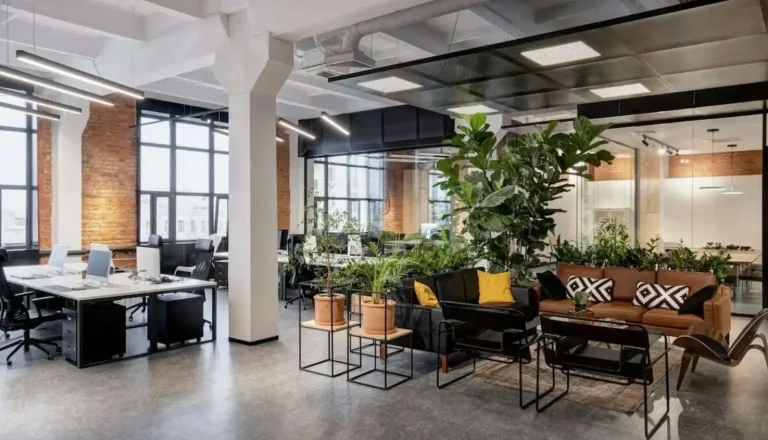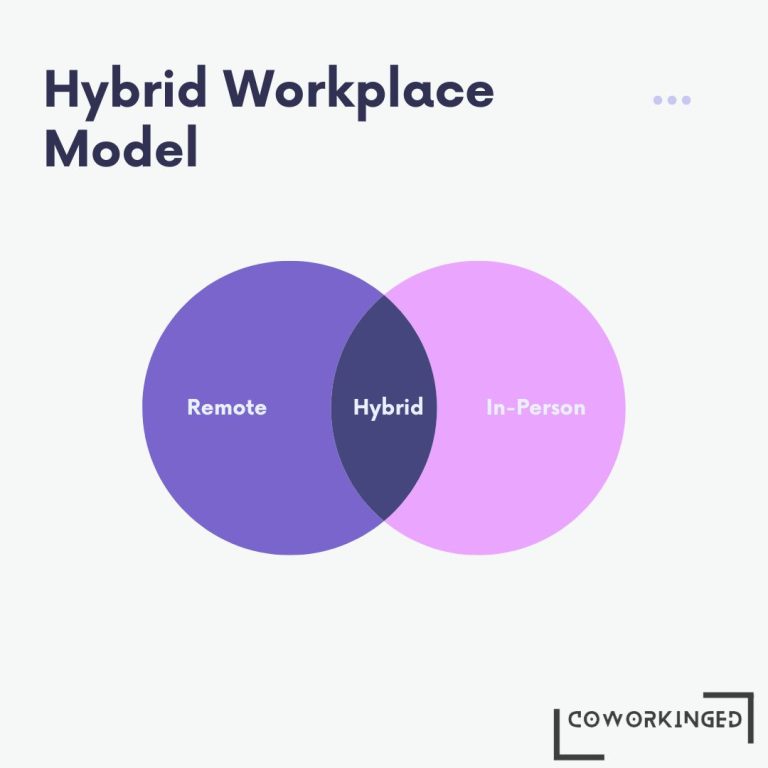What is an agile workplace?
The meaning of “agile” in business has evolved over the years. Originally, it referred to a specific set of software development practices created in the mid-’90s to complete projects quickly and efficiently.
Now, “agile” extends beyond software development. It’s about being flexible in how we approach all types of work. It also describes modern office layouts designed to support this approach. An agile work environment replaces the old, rigid office with versatile shared spaces. Employees can work where and when they prefer.
What is an Agile Workplace?
An agile workplace is all about freedom and flexibility. It’s not your typical office, where you have a fixed desk. Instead, in an agile workplace, you’re like a free bird in the office.
Imagine this: you can pick any spot in the office that suits your needs at any given moment. Need a quiet corner for focused work? Go for it. Want to collaborate with your team in a cozy meeting nook? That’s an option too.
Agile workplaces are not just about the physical space; they’re about how work happens. It’s about choosing when and where you work best. This approach promotes teamwork, sparks creativity by breaking down barriers, and, most importantly, makes employees happier.
Now, you might have heard of hybrid workplaces. They sound similar, but there’s a difference. Hybrid workplaces support remote work, whether you’re in the office or not. Agile workplaces focus on giving you the power to decide where you work within the office. It’s all about making your work environment work for you.

Different Types of Agile Workspaces
Agile workspaces come in various forms, all designed to provide flexibility and accommodate the preferences and comfort of employees. These spaces are key components of an agile workplace, working together to create an environment that enhances productivity and adaptability.
Open plan areas
One fundamental element of an agile workspace is the open-plan area. It serves as the central hub of the agile workplace, promoting collaboration and communication among employees. This open and interactive environment is particularly beneficial for creative teams working on projects that require frequent idea-sharing and discussion. However, it’s important to recognize that open spaces may not suit everyone’s work style. To address this, agile workplaces incorporate quieter zones and breakout spaces where individuals can retreat for focused work.
Quiet zones
Quiet zones are essential in an agile workspace, providing employees with a place for concentration and privacy. These areas may include soundproof phone booths equipped with the necessary tools for undisturbed work. Alternatively, they could serve as tranquil spaces for employees to gather their thoughts and alleviate stress, creating a sanctuary amidst the bustling office environment.
Breakout spaces
Breakout spaces are the more informal and relaxed sections of an agile workplace. These areas are versatile and cater to various purposes, from casual interactions and team meetings to brainstorming sessions. They offer employees a place to unwind, share ideas with colleagues, or take a break from their screens, fostering a sense of community and relaxation.
Resource areas
Resource areas are dedicated to the practical needs of employees throughout the day. They house essential equipment such as printers, scanners, recycling bins, and office supplies. While these resource areas are indispensable, they tend to be noisier by nature. To strike a balance, they are strategically placed to be easily accessible without causing disruptions in the primary work areas.
Touchdown spaces
Touchdown spaces are designed for quick and informal bursts of productivity. These spaces come in various sizes and configurations, providing employees with a spot to quickly set up their laptops for tasks like sending an email or addressing less critical work. They can range from simple workstations to standing desks located in the lobby or focus-enhancing phone booths that offer isolation from the rest of the office.
Why Are Agile Workplaces Gaining Popularity?
The rise of agile workplaces isn’t just a passing trend; it’s a response to changing needs in our working world, and recent events have accelerated this shift. Traditional offices are transforming to become more adaptable and better suited to the evolving demands of both employers and employees.
From a business owner’s perspective, embracing an agile workspace presents an opportunity to optimize existing office resources. With a growing number of employees working remotely, shifting to an agile office layout allows companies to save money by repurposing or downsizing underutilized office space.
For employees, especially those who’ve experienced remote work during the COVID-19 pandemic, the traditional office no longer holds the same appeal. They’re not keen on returning to the same old desks for five days a week. Instead, they desire access to flexible office space that aligns with their new workstyle. They want a workspace that’s available when they need it and designed to encourage communication, creativity, and interaction – a space that caters to their changing work preferences. This shift towards agility reflects a modern approach to work that prioritizes adaptability and employee satisfaction.
The Advantages of an Agile Workplace
- Enhanced Collaboration: An agile workplace fosters collaboration by allowing employees to move freely around the office. This freedom creates pockets of teamwork, experimentation, and creativity. Work isn’t tied to a fixed location or a row of desks, making it easier for ideas to flow between different departments that may have otherwise remained isolated.
- Improved Employee Retention: Flexibility in choosing where and when to work is a top priority for many millennials. Offering an agile workspace that aligns with this preference can be a powerful tool for attracting and retaining top talent. It shows that the company values the well-being and needs of its employees.
- Efficient Space Utilization: Even before the pandemic, businesses wasted significant resources on unused desk space. Transitioning to an agile workplace presents an opportunity to optimize office layouts fully. This means repurposing neglected meeting rooms and shedding unnecessary space, leading to cost savings and a more efficient use of resources.
- Heightened Employee Satisfaction: Workplace flexibility plays a crucial role in job satisfaction. An agile workplace promotes this flexibility, empowering employees to approach tasks on their terms. It instills trust in employees to manage their time and workload effectively, contributing to higher job satisfaction.
- Increased Productivity: Many of us know that escaping a noisy environment can do wonders for productivity. An agile workplace accommodates this by providing spaces for collaboration when needed and quiet zones for focused work. It allows employees to choose the most conducive environment for their tasks, ultimately boosting overall productivity.
Which Companies Can Embrace Agile Workplaces?
Not every company can seamlessly transition to an agile workspace, especially those relying on physical presence during regular office hours. However, the COVID-19 pandemic has shown that flexibility is possible for many businesses.
Agile workplaces are particularly well-suited for companies with clear goals and adaptable processes, especially those in collaborative and social industries. Creative designers, product developers, software firms, and corporate teams are examples of businesses that can reap the rewards of agile office spaces. These environments provide the freedom and autonomy that align with the dynamic needs of these industries.
Adapting to an Agile Workplace: Overcoming Challenges
Shifting to an agile work environment isn’t an overnight makeover; it’s a transformative process that reshapes how your company functions. Here are some key strategies for successfully embracing this change:
- Engage Your Teams: To make agile working a success, involve the very people who will be using it – your employees. Seek their input early in the process, and prioritize understanding and addressing their concerns and needs. Clearly communicate why this shift is happening and what they can expect from the new work environment.
- Clarify the New Setup: Change can be confusing, so equip every employee with the necessary tools to remain productive. Ensure they fully understand the new processes, such as reserving workspace, utilizing meeting rooms, accessing resources, booking services, and staying in touch with colleagues.
- Take Incremental Steps: Transitioning to an agile workplace doesn’t have to be a giant leap. Instead, take gradual, manageable steps. Implement changes to your workflow and introduce new office spaces in phases. At each stage, evaluate whether you’re aligning with your objectives. This gradual approach allows for a smoother transition and greater adaptability.
Closing Thoughts
Adopting an agile workplace is a journey, not a sprint. It’s about creating a work environment that adapts to the changing needs of both your company and your employees. By involving your teams, providing clarity in the new setup, and taking incremental steps, you can successfully navigate the challenges and reap the rewards of increased collaboration, employee satisfaction, and efficient resource utilization. Remember, the path to agility may have its challenges, but it ultimately leads to a more resilient and dynamic workplace, well-equipped for the future.
People Also Ask
1. What is an example of agile work?
An example of agile work is when a software development team divides a project into smaller tasks (sprints) to work on over short periods, often two to four weeks. They assess progress at the end of each sprint, adapting their plan as needed, and fostering flexibility and teamwork while efficiently responding to changing project requirements or priorities.
2. What is an agile work environment?
An agile work environment is a flexible workspace that allows employees to choose where and how they work, adapting to their preferences and needs. It encourages collaboration, offers various work settings, and supports a dynamic approach to tasks, ultimately promoting efficiency and employee satisfaction.
3. What is the meaning of working in an agile environment?
Working in an agile environment means embracing a flexible and adaptable way of working. It involves collaborating effectively, being open to change, and focusing on delivering incremental results. This approach values teamwork, quick responses to shifting priorities, and continuous improvement to achieve success.






